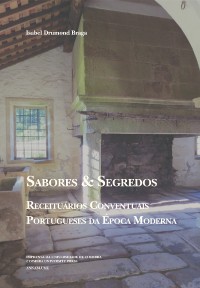Please use this identifier to cite or link to this item:
https://hdl.handle.net/10316.2/37357| Title: | Sabores e segredos: receituários conventuais portugueses da Época Moderna | Other Titles: | Flavours and secrets: portuguese conventual recipes of Modern Age | Authors: | Braga, Isabel Drumond | Keywords: | Sweets;Franciscans of the Province of Algarve;Order of the Visitation of the Holy Mary;Portuguese Conventual Recipes;Doçaria;Franciscanos da Província dos Algarves;Ordem da Visitação de Santa Maria;Receituários conventuais portugueses | Issue Date: | 2015 | Publisher: | Imprensa da Universidade de Coimbra | Abstract: | This work consists of the transcription, analysis and interpretation of two unpublished eighteenth-century conventual recipes, which were compared with other counterparts in near periods, produced within the same scope and among the laity. The course undertaken aimed at assessing the real or imaginary originality of the recipes prepared in religious houses of the Modern Age and permitted to answer several questions, namely: the extent to which the conventual recipes were created in this scope or were taken to the monasteries by nuns, friars, monastic nuns, monks, maids and servants? Since the ingredients and cooking techniques used in religious houses were known in the places where lay people were, especially among confectioners, whose regiments were clear about the requirements to obtain letter, how can we explain the frenzy, often excessive, the conventual designation applied to so many and so frenetic recipes? In fact monks, monastic nuns, nuns, friars, maids and servants had time to cook and it is possible that many, or at least some, appreciated the preparation of savoury dishes and especially sweets. However, wasn’t the offer and commerce of sweets the most responsible for the exaltation of the conventual designation, in the absence of pastries taking place in the 17th and 18th centuries, and confectioneries whose fame would spread out to the Kingdom? Are we dealing with the creation of truly conventual sweets or sheer preparations of recipes originally produced in the kitchens of big houses and subsequently taken to the monasteries, such as so many other meat and fish recipes?
The analysis and the interpretation of the sources made very clear that the overwhelming majority of the recipes prepared in religious houses was hardly original, we just have to compare these recipes with those circulating both handwritten and printed in other recipe books of the time. On the other hand, the alleged secrecy that should involve the aforementioned conventual recipes - and this is evident in some female recipe books - was broken, in such a manner that lay cookbooks include recipes with names of some religious houses, which does not necessarily mean these recipes have originated there but that they were prepared successfully there and the subject of appreciation by those who had the opportunity to taste them. Esta obra consiste na transcrição, análise e interpretação de dois receituários conventuais setecentistas inéditos, os quais foram objecto de comparação com outros congéneres de épocas próximas, produzidos no mesmo âmbito e entre os leigos. O percurso empreendido procurou avaliar a originalidade real ou imaginária das receitas preparadas nas casas religiosas da Época Moderna e permitiu responder a várias interrogações, destaquem-se algumas: até que ponto as receitas conventuais foram criadas nesse âmbito ou foram levadas para os cenóbios por freiras, frades, monjas monges, criadas e criados? Atendendo a que os ingredientes e as técnicas culinárias utilizados nas casas religiosas eram conhecidos nos espaços de leigos, mormente entre os confeiteiros, cujos regimentos eram claros acerca das exigências para se obter carta, como se explica o furor, muitas vezes desmedido, da designação conventual aplicada a tantas e tão desvairadas receitas? É certo que monges, monjas, freiras, frades, criados e criadas tinham tempo para a culinária e é admissível que muitos, ou pelo menos alguns, apreciassem a preparação de pratos salgados e especialmente de doçaria. Porém, não terão sido as ofertas e a comercialização dos doces os principais responsáveis pela exaltação da designação conventual, na falta, verificada nos séculos XVII e XVIII, de pastelarias e confeitarias cuja fama se expandisse pelo Reino? Estaremos perante criações de doces genuinamente conventuais ou meras execuções de receitas inicialmente produzidas nas cozinhas de grandes casas e, posteriormente, levadas para os cenóbios, tal como tantas outras receitas de carne e de peixe? A análise e a interpretação das fontes tornaram muito claro que a esmagadora maioria das receitas preparadas nas casas religiosas nada tinha de original, basta comparar essas receitas com as que circulavam manuscritas ou impressas em outros receituários da época. Por outro lado, o pretenso sigilo que deveria envolver as receitas ditas conventuais – e isso é patente em alguns receituários femininos – era quebrado, de tal modo que livros de cozinha de leigos integram receitas com designações de algumas casas religiosas, o que não significa necessariamente que essas receitas aí tenham sido criadas mas sim que aí eram preparadas com êxito e objecto de apreço por quem tinha oportunidade de as degustar. |
URI: | https://hdl.handle.net/10316.2/37357 | ISBN: | 978-989-26-1079-5 978-989-26-1080-1 (PDF) |
ISSN: | 2183-6523 | DOI: | 10.14195/978-989-26-1080-1 | Rights: | open access |
| Appears in Collections: | Pombalina |
Files in This Item:
| File | Description | Size | Format | |
|---|---|---|---|---|
| sabores_e_segredos.pdf | 6.34 MB | Adobe PDF |  |
Items in DSpace are protected by copyright, with all rights reserved, unless otherwise indicated.
